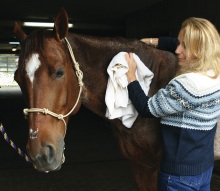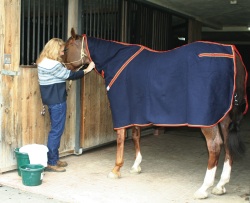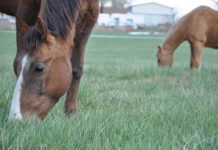Oh, how we love to ride in the winter! Our toes and fingers might be painfully cold, but our hearts are warmed by the sound of our horses’ hooves and the sweet smell of their breath in the frosty air.
1. Hot Towel Treatment
 A towel bath is a bit of a workout for you, but it will get your horse surprisingly clean. Thoroughly groom your horse first to remove any caked-on mud and dirt. Then collect several medium-sized towels, and fill a 5-gallon bucket with the hottest water you can find. (Cold water will suffice if that’s what you have access to, but don’t discount a trek to the kitchen sink.) The hotter the water, the better it will pick up dirt and dust. You can use rubber kitchen gloves if the water temperature is uncomfortable on your hands.
A towel bath is a bit of a workout for you, but it will get your horse surprisingly clean. Thoroughly groom your horse first to remove any caked-on mud and dirt. Then collect several medium-sized towels, and fill a 5-gallon bucket with the hottest water you can find. (Cold water will suffice if that’s what you have access to, but don’t discount a trek to the kitchen sink.) The hotter the water, the better it will pick up dirt and dust. You can use rubber kitchen gloves if the water temperature is uncomfortable on your hands.
Soak a towel in the bucket of water, wring out as much of the water as you can, and rub the hair briskly in both directions (with and against the hair growth). Rinse out the towel as necessary and repeat, working over small sections at a time. You may need to change the water if it gets dirty.
When you finish an area, take a dry towel and rub the hair in the same manner. Your last stroke should be against the direction the hair grows so it is standing up; this will help it dry quicker. As soon as you finish toweling, cover your horse with a cooler to keep him from getting chilled and to speed drying. Once he is dry, spray his coat with a coat conditioner to moisturize the hair and help repel dust, then finish with a regular brushing.
2. Sponge Bath
Regardless of how thoroughly you brushed your horse before riding, you may still have mud-caked sweat to contend with afterward. Sponge bathing with warm water is the best method for a full-body bath in the cold; you can keep half of his body covered with a cooler while washing the other half.
A large, coarse sponge is best to use for a post-ride rubdown. Squeeze excess water out of the sponge and scrub the sweaty areas, starting at your horse’s ears. If he has worked up a good sweat, these areas may be foamy. Frequently rinse out the sponge and continue scrubbing the sweaty parts until the foam is gone. Finally, rub the areas with a dry towel and leave the hair standing up. A cooler will help wick moisture from the coat and keep him warm as he dries.
3. Braving the Cold
 Although it may be too cold for a full bath, you can generally hose off your horse from the elbows down without making him uncomfortable.
Although it may be too cold for a full bath, you can generally hose off your horse from the elbows down without making him uncomfortable.
To get your horse accustomed to the cold water, particularly if he is still hot from a workout, start at the bottom of his legs and slowly work your way up. By the time you reach the top of his legs, he should be acclimated to the water, and you can wash his girth area and between his front and back legs without worrying about him getting chilled.
Work as quickly as possible in an area protected from drafts or wind. Avoid getting cold water along his topline or the hindquarters, as these areas are more sensitive to cold and will cause him to become chilled. Rub him down thoroughly with dry towels when you finish, and cover him with a cooler until he is dry.
You can also wash your horse’s tail in cold water, provided you wash below the tailbone. Use a sponge for the top part of his tail. Because there are no flies to contend with during the winter, you can also braid or bag your horse’s tail to help keep it clean.
Keep in mind that cold weather bathing is generally best suited for a mild winter climate or a heated wash rack.
4. Don’t Forget Those Forgettable Areas
When grooming your horse, pay particular attention to the areas around his ears, under his jaw and at the back of his fetlocks. They are prone to being irritated by dirt and sweat residue that can lead to winter sores. You can also clip under the jaw and at the back of the fetlocks to help prevent sores.
5. Just a Trace
A body-clipped horse must be adequately blanketed to stay protected from the cold. If your horse lives outside in a paddock or pasture, it is not advisable to fully body clip him. You can, however, give him a partial clip. A trace clip is one of the more conservative cuts: Cut along the under-part of his neck, behind his elbows, along his belly and around his flank. A horse typically sweats the most in these areas. Your horse will sweat less if these areas are exposed, and post-ride cleanup will be easier.
6. Hot on Demand
You can purchase a small water heater that drops into a wash bucket. These heaters are designed for use in a 5-gallon bucket. Be sure to purchase one with a guard around the heating element and an automatic shut-off. To be safe, never leave these heaters unattended. Portable water heating units for your wash rack are available at a slightly greater expense and provide hot water on demand.
7. Turn Out in Style
Consider investing in a waterproof turnout blanket. Even if your horse has a full winter coat and lives out on pasture, a medium or lightweight turnout blanket (appropriate to your climate) can provide added warmth and protection on subfreezing nights and during winter storms. It will also keep your horse cleaner.
8. Suck it Up!
For less than $200, you can purchase a horse vacuum with a variety of attachments. You will need to desensitize your horse to its sound and feel, but once you do, vacuuming is a beneficial addition to brushing and currying a thick winter coat.
Keeping your horse clean during the winter months is challenging, but it’s worth the extra effort. Your horse may still be as wooly as a mammoth, but he will be clean and ready for a day’s ride.
Further Reading
The Big Chill
Blanket Central







It’s all good advice.
Here’s what I do in the winter: I curry and brush my mare thoroughly, then I scrub her down with packaged, pre-moistened pet wipes (like BIG baby wipes) available at the 99 Cent Store or any dollar-type store. There are 6 to 8 in a package, depending on the brand. My mare is just 15.2h so she’s not huge, but it only takes one pkg. of eight of these wipes to get her shiny. I only clean her mane and tail at the roots, wiping the long hairs to finish. One wipe will clean the entire face (do eyes first, nostrils last). It works! She loves it, and it only costs a buck!
Instead of using towels to dry my horses I invested in some shamwow towels. They suck up the water EXACTLY like the site claims and then some! https://shamwow.com/ver8/index.asp
I wish I had these years ago.
I really liked it, good info!!
LOVE Penny’s suggestion about the large pet wipes. I’m going to look for some tonight!
Great idea Penny!
Also, you can get Bit warmers -> http://www.BittenStore.com
Some people get hindquarter covers that fit on the back of your horse. So when you’re riding, your horse can stay warm.
And, even though this doesn’t have to do with winter, if your horse doesn’t like his bit, get him Bit Wipes. They taste like apples, and carrots, and other flavors!
Thats really cool! My horse is getting really dirty in the winter months and I didn’t want to hose her.
This is a great idea! Thanks for the article.
great idea of using hot/warm towels to wash down my horse. He is all white and loves rollong in mud when turned out. He comes back with wet mud. Even brushing only causes the mud to smear all ove his body.
Rubbing him down with hot wet towels would feel really great for his old bones.
Interesting! I hope that everyone has a great,safe weekend! I also hope that they had a great Christmas and that they have a happy and safe New Year.
This is a great article as we head into the winter months. I am definitely going to put these ideas to work.
Sounds like an idea.